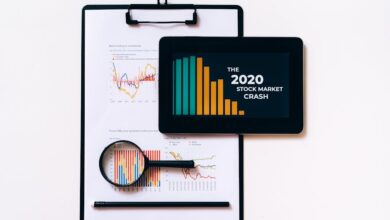Weathering the Storm: Understanding Economic Recessions, Their Impact, and Strategies for Resilience

As the global economy continues to evolve, the specter of recession looms as a recurring challenge that can disrupt markets, alter consumer behavior, and strain businesses across various sectors. Understanding the early warning signs of an impending recession is crucial for investors, policymakers, and consumers alike. This article delves into the multifaceted nature of economic downturns, exploring how they impact different sectors, the strategies investors can employ during turbulent times, and the critical role of government stimulus in providing relief. Additionally, we will examine shifts in consumer behavior and the implications for global trade and supply chains. By drawing lessons from past recessions, we aim to equip businesses with actionable insights to prepare for and navigate the uncertainties ahead. Join us as we unpack these vital topics to better understand the complexities of economic recessions and the pathways to resilience.
- 1. Recognizing the Red Flags: Early Warning Signs of an Economic Recession
- 2. Navigating Turbulence: The Impact of Recessions on Sectors and Strategies for Investment
- 3. Resilience in Crisis: Government Stimulus, Consumer Behavior, and Global Trade Dynamics During Economic Downturns
1. Recognizing the Red Flags: Early Warning Signs of an Economic Recession
Recognizing early warning signs of an economic recession is crucial for businesses, investors, and policymakers alike. Several key indicators can signal an impending downturn, allowing stakeholders to take proactive measures.
One of the primary signs is a decline in consumer confidence. When consumers feel uncertain about their financial future, they tend to reduce spending, which can lead to lower sales for businesses. A significant drop in consumer sentiment, often measured by surveys, can foreshadow decreased economic activity.
Another important indicator is the performance of leading economic indicators, such as the stock market, manufacturing activity, and new housing starts. A sustained downturn in these areas often precedes a recession. For instance, a decrease in manufacturing orders may suggest that companies anticipate reduced demand, prompting them to cut back on production and investment.
Unemployment rates can also provide insight into economic health. A sudden rise in jobless claims or an increase in the unemployment rate may indicate that businesses are struggling and may be forced to downsize their workforce, further dampening economic growth.
Additionally, changes in interest rates can signal shifts in economic conditions. Central banks may lower rates to stimulate borrowing and spending in response to slowing growth. Conversely, rising rates can indicate efforts to combat inflation but may also hinder economic expansion.
Finally, shifts in inflation rates should be monitored. High inflation can erode purchasing power and squeeze consumer budgets, leading to reduced spending and potential recessionary pressures. Conversely, deflation can signal weak demand and economic stagnation.
By closely observing these indicators—consumer confidence, leading economic indicators, unemployment rates, interest rates, and inflation—stakeholders can better understand the economic landscape and prepare for potential challenges ahead.
2. Navigating Turbulence: The Impact of Recessions on Sectors and Strategies for Investment
Recessions can have varied impacts on different sectors of the economy, creating both challenges and opportunities for investors. Typically, consumer-oriented sectors such as retail, travel, and hospitality experience significant declines in demand as households tighten their budgets and prioritize essential spending. Conversely, sectors like utilities and consumer staples, which provide essential goods and services, often demonstrate resilience during economic downturns. These industries tend to maintain stable revenue streams as consumers continue to purchase necessities, making them more attractive to investors seeking safety during turbulent times.
In the financial sector, banks may face increased loan defaults, leading to tighter credit conditions. This can adversely affect lending and investment activities. However, some financial institutions may also find opportunities in undervalued assets or distressed loans, allowing savvy investors to capitalize on market dislocations.
When it comes to investment strategies during a recession, a defensive approach is often prudent. Investors may consider reallocating their portfolios to include more stable, dividend-paying stocks and sectors that historically perform well in downturns. Additionally, fixed-income securities, such as government bonds, can provide a buffer against equity market volatility. Diversification remains a key strategy, as it allows investors to mitigate risks associated with individual sectors while capitalizing on potential growth in others.
Moreover, sectors associated with innovation and technology can present unique opportunities, even during recessions. Companies that provide cost-saving technologies or services may see increased demand as businesses and consumers seek efficiencies. Investors willing to identify and invest in these growth areas can benefit even in challenging economic climates.
Ultimately, navigating the turbulence of a recession requires a keen understanding of sector dynamics and a flexible investment approach. By focusing on industries with resilient demand and exploring opportunities in innovative sectors, investors can position themselves to weather economic downturns while potentially achieving favorable returns.
3. Resilience in Crisis: Government Stimulus, Consumer Behavior, and Global Trade Dynamics During Economic Downturns
During economic downturns, resilience is often tested across various sectors, and government stimulus plays a crucial role in stabilizing the economy. When a recession hits, governments typically implement fiscal policies designed to inject liquidity into the market and support individuals and businesses. These measures can include direct financial assistance, tax relief, and funding for public projects, all aimed at boosting consumer confidence and stimulating demand. The effectiveness of such stimulus packages can significantly impact the depth and duration of a recession.
Consumer behavior tends to shift markedly during economic downturns, as uncertainty leads individuals to prioritize essentials and reduce discretionary spending. This change can ripple through the economy, affecting various industries differently. For example, sectors like retail and hospitality may experience declines in sales, while others, such as discount retailers and grocery stores, might see an uptick in demand. Businesses that adapt to these shifting consumer preferences—by offering value-oriented products or services—stand a better chance of weathering the storm.
Global trade dynamics also undergo significant transformations during recessions. Trade volumes often contract as demand falls, disrupting supply chains that have become increasingly interconnected. Countries may resort to protectionist measures to shield their domestic industries, further complicating international trade relationships. As a result, businesses reliant on global supply chains may need to rethink their strategies, potentially seeking local suppliers or diversifying sources to mitigate risks associated with economic instability.
Overall, the interplay between government stimulus, changing consumer behavior, and global trade dynamics shapes the resilience of economies during crises. Understanding these factors can help stakeholders—from policymakers to business leaders—navigate the complexities of economic downturns and implement strategies that promote recovery and growth.
In conclusion, understanding the multifaceted nature of economic recessions equips individuals, businesses, and governments to navigate these challenging periods more effectively. Recognizing early warning signs can empower stakeholders to take proactive measures, while a nuanced appreciation of how different sectors are impacted can inform strategic investment decisions. The role of government stimulus emerges as a critical tool for mitigating the adverse effects of recessions, offering support to both consumers and businesses alike.
Additionally, shifts in consumer behavior during downturns highlight the necessity for businesses to adapt and innovate to maintain resilience. The interconnectedness of global trade and supply chains further underscores the importance of strategic planning and flexibility in response to external pressures.
Reflecting on lessons from past recessions reveals valuable insights that remain relevant today, emphasizing the importance of preparedness and adaptability. By implementing robust strategies and maintaining a forward-thinking mindset, businesses can not only survive but also thrive in the face of economic adversity. Ultimately, a comprehensive understanding of these dynamics fosters a more resilient economic landscape, ready to face future challenges with confidence.





